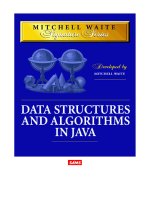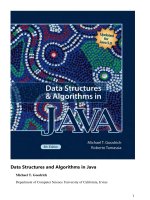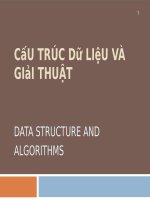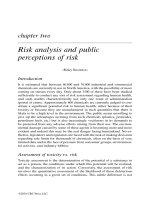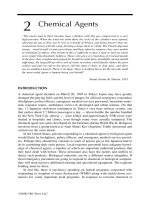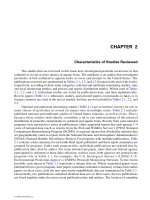Data Structure and Algorithms CO2003 Chapter 2 Algorithm Complexity
Bạn đang xem bản rút gọn của tài liệu. Xem và tải ngay bản đầy đủ của tài liệu tại đây (214.62 KB, 33 trang )
Data Structure and Algorithms [CO2003]
Chapter 2 - Algorithm Complexity
Lecturer: Duc Dung Nguyen, PhD.
Contact:
August 22, 2016
Faculty of Computer Science and Engineering
Hochiminh city University of Technology
Contents
1. Algorithm Efficiency
2. Big-O notation
3. Problems and common complexities
4. P and NP Problems
1
Outcomes
• L.O.1.1 - Define concept “computational complexity” and its special
cases, best, average, and worst.
• L.O.1.2 - Analyze algorithms and use Big-O notation to
characterize the computational complexity of algorithms composed
by using the following control structures: sequence, branching, and
iteration (not recursion).
• L.O.1.3 - List, give examples, and compare complexity classes, for
examples, constant, linear, etc.
• L.O.1.4 - Be aware of the trade-off between space and time in
solutions.
• L.O.1.5 - Describe strategies in algorithm design and problem
solving.
2
Algorithm Efficiency
Algorithm Efficiency
• A problem often has many algorithms.
• Comparing two different algorithms ⇒ Computational complexity:
measure of the difficulty degree (time and/or space) of an algorithm.
• How fast an algorithm is?
• How much memory does it cost?
3
Algorithm Efficiency
General format
efficiency = f(n)
n is the size of a problem (the key number that determines the size of
input data)
4
Linear Loops
f o r ( i = 0 ; i < 1 0 0 0 ; i ++)
// a p p l i c a t i o n c o d e
The number of times the body of the loop is replicated is 1000.
f(n) = n
f o r ( i = 0 ; i < 1 0 0 0 ; i += 2 )
// a p p l i c a t i o n c o d e
The number of times the body of the loop is replicated is 500.
f(n) = n/2
5
Linear Loops
time
f (n) = n
f (n) = n/2
n
6
Logarithmic Loops
Multiply loops
i = 1
w h i l e ( i <= n )
// a p p l i c a t i o n c o d e
i = i x 2
end w h i l e
Divide loops
i = n
w h i l e ( i >= 1 )
// a p p l i c a t i o n c o d e
i = i / 2
end w h i l e
The number of times the body of the loop is replicated is
f(n) = log2 n
7
Logarithmic Loops
time
f (n) = log2 n
n
8
Nested Loops
Iterations = Outer loop iterations × Inner loop iterations
Example
i = 1
w h i l e ( i <= n )
j = 1
w h i l e ( j <= n )
// a p p l i c a t i o n c o d e
j = j ∗ 2
end w h i l e
i = i + 1
end w h i l e
The number of times the body of the loop is replicated is
f (n) = n log2 n
9
Nested Loops
time
f (n) = n log2 n
n
10
Quadratic Loops
Example
i = 1
w h i l e ( i <= n )
j = 1
w h i l e ( j <= n )
// a p p l i c a t i o n c o d e
j = j + 1
end w h i l e
i = i + 1
end w h i l e
The number of times the body of the loop is replicated is
f (n) = n2
11
Dependent Quadratic Loops
Example
i = 1
w h i l e ( i <= n )
j = 1
w h i l e ( j <= i )
// a p p l i c a t i o n c o d e
j = j + 1
end w h i l e
i = i + 1
end w h i l e
The number of times the body of the loop is replicated is
1 + 2 + . . . + n = n(n + 1)/2
12
Quadratic Loops
time
f (n) = n2
n
13
Asymptotic Complexity
• Algorithm efficiency is considered with only big problem sizes.
• We are not concerned with an exact measurement of an algorithm’s
efficiency.
• Terms that do not substantially change the function’s magnitude are
eliminated.
14
Big-O notation
Big-O notation
Example
f (n) = c.n ⇒ f (n) = O(n)
f (n) = n(n + 1)/2 = n2 /2 + n/2 ⇒ f (n) = O(n2 )
• Set the coefficient of the term to one.
• Keep the largest term and discard the others.
Some example of Big-O:
log2 n, n, n log2 n, n2 , ... nk ... 2n , n!
15
Standard Measures of Efficiency
Efficiency
logarithmic
linear
linear log
quadratic
polynomial
exponential
factorial
Big-O
Iterations
Est. Time
O(log2 n)
O(n)
O(n log2 n)
O(n2 )
O(nk )
O(2n )
O(n!)
14
10 000
140 000
100002
10000k
210000
10000!
microseconds
0.1 seconds
2 seconds
15-20 min.
hours
intractable
intractable
Assume instruction speed of 1 microsecond and 10 instructions in loop.
n = 10000
16
Standard Measures of Efficiency
time
n2 n log n
2
n
log2 n
n
17
Big-O Analysis Examples
Algorithm addMatrix(val matrix1<matrix>, val matrix2<matrix>, val
size<integer>, ref matrix3<matrix>)
Add matrix1 to matrix2 and place results in matrix3
Pre: matrix1 and matrix2 have data
size is number of columns and rows in matrix
Post: matrices added - result in matrix3
r=1
while r <= size do
c=1
while c <= size do
matrix3[r, c] = matrix1[r, c] + matrix2[r, c]
c=c+1
end
r=r+1
end
return matrix3
End addMatrix
18
Big-O Analysis Examples
Nested linear loop:
D
f (S) = O(
Si )
i=1
f (size) = O(size2 )
19
Time Costing Operations
• The most time consuming: data movement to/from
memory/storage.
• Operations under consideration:
• Comparisons
• Arithmetic operations
• Assignments
20
Problems and common
complexities
Binary search
Recurrence Equation
An equation or inequality that describes a function in terms of its value
on smaller input.
1
2
3
5
8
13
21
34
55
89
T (n) = 1 + T (n/2) ⇒ T (n) = O(log2 n)
21

